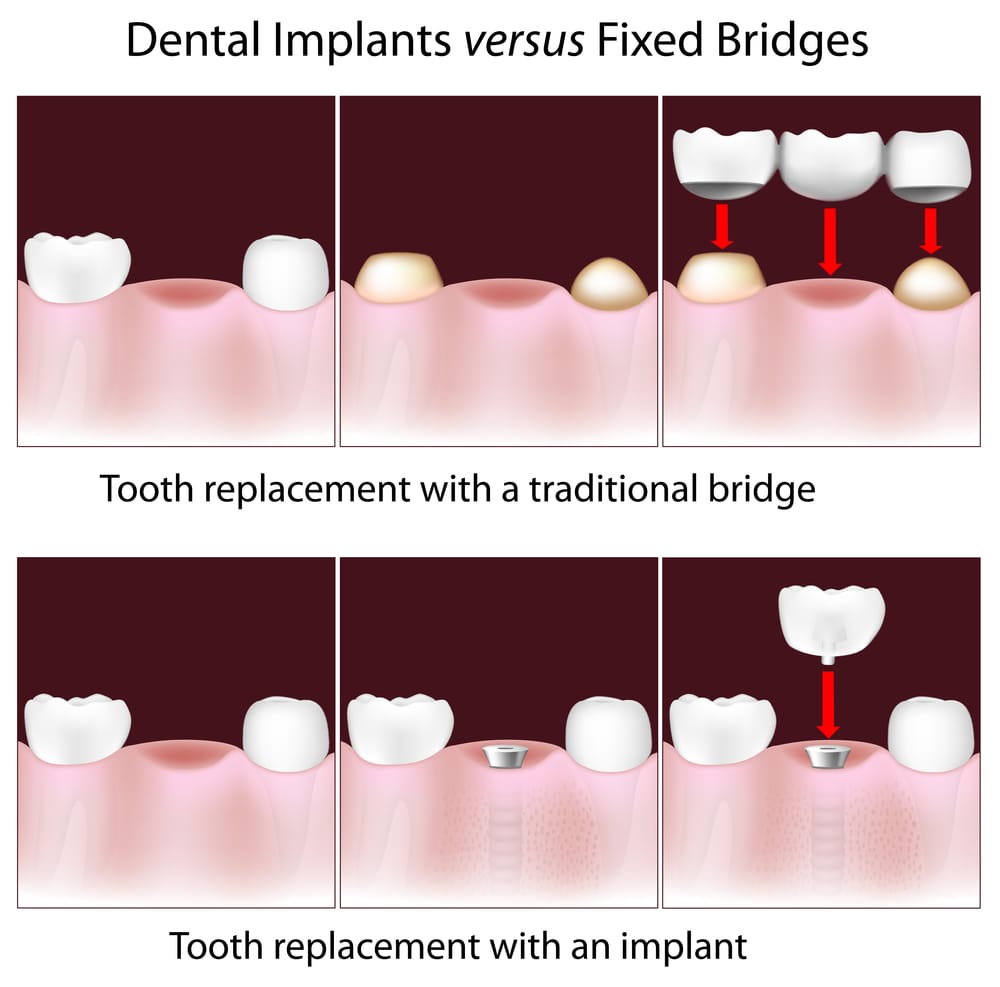
When you are faced with the issue of a missing tooth or teeth that are damaged to the point of needing replacement, two of the main options to replace your teeth are dental implants and dental bridges. Our dental office here at Riverside Dental Care offers both types of dental treatment and often helps patients determine which teeth replacement option is best for their lifestyle, budget, and long-term needs.
To help you learn more about your options, we wanted to provide an in-depth comparison of dental bridges vs dental implants so that you can be prepared with all the necessary information when it comes time to choose.
What Are Dental Implants And Dental Bridges
Before we jump into the benefits, it is important to define what are dental bridges and dental implants.
Dental Bridge
A traditional dental bridge is made up of replacement teeth placed in a bridge that is designed to blend in with your gums. Two of the remaining teeth will be shaped, one on either side of where the teeth are missing, to allow the bridge to be placed over and cemented into place.
Often, dental bridges are best for when you need three or fewer teeth replaced. Beyond that, a partial denture may be a better option. There are also different types of dental bridges that can be used, such as:
Maryland bridge

Instead of shaping two of your teeth, a replacement tooth can be placed by attaching a resin bridge behind two of your natural teeth, bracing and connecting the new tooth.
This Maryland bridge is also called a resin bridge, is a fairly affordable option that can work for a missing front tooth, as they are not expected to exert much pressure. They can pop off of but are usually easily reattached.
Cantilever bridge

Another alternative to reshaping two of your teeth, a cantilever bridge requires just one tooth to be reshaped and the replacement tooth is supported by the one capped tooth. Again, this strategy is best for front teeth that aren’t expected to do as much chewing, as it is not as secure as a traditional bridge.
Implanted bridge

Blending dental implants with dental bridges, you can have a dental bridge affixed by having the bridge implanted into your jawbone. This option is by the sturdiest type of bridge and allows you to have multiple teeth replaced more affordable than if you tried to replace multiple teeth with dental implants.
Dental Implant
Dental implants are made up of three parts—titanium rod, abutment, and crown. As a more permanent solution, having a dental implant placed can take far more time than a dental bridge, as it starts with having the titanium rod implanted into the jawbone.
After healing and allowing the jawbone to knit around the rod, the abutment is placed and crowned with the replacement tooth. The usefulness and greater stability offered by implanted rods have led dentists to combine dental implants with both dental bridges and dentures. However, for comparison’s purposes, we will be mostly focusing on contrasting non-implant dental bridges to dental implants.
Costs Of Dental Bridges vs Dental Implants
A significant factor when it comes to deciding between these two teeth replacement options is their costs.
In most cases, a dental bridge will be a more affordable option than a dental implant. For one thing, dental insurance often will extend to cover dental bridges while they don’t cover dental implants as often. Also, dental implants require surgery and more dental visits, and the additional work of placing an implant raises the price of the dental device.
How many teeth need to be replaced also highly influence the cost of the replacement dental work. Prices are dependent on a variety of factors such as if you need bone grafting, have additional work that needs to be done, what materials are used, and more. Our dentists will be able to give you more specific pricing when you discuss your options with them.
Benefits Of Dental Implants vs Dental Bridges
| Dental Bridge | Dental Implant | |
| Dental Impact Long Term | Can experience gum recession and jawbone density loss | Very little to no loss of gums or bone density, as the implant supports both |
| Looks | Generally, looks natural and undetectable | Most natural-looking dental replacement option |
| Length Of Procedure | Takes a few dental visits over the course of a couple of weeks | Can take at least 3 months and up to 6 months with multiple visits |
| Durability | Sturdy, allows for natural conversation but some options are less durable | Can act just like natural teeth with no need to worry about chewing or speaking |
| Lifespan | Generally lasts 5-7 years | Can last 15 or more years |
| Oral Hygiene | Need specialized tools to floss and brush | Clean with floss and brushing like normal teeth |
Consult With Riverside Dental Care On Your Dental Needs
Just knowing the differences between these two types of dental replacements isn’t enough to be sure which is right for you. Our dentists here at Riverside Dental Care can work with you one-on-one to determine whether dental implants or dental bridges are best for your lifestyle, budget, and other concerns.
For quality dental work from experienced dentists, contact Riverside Dental Care. Our dentists will be happy to consult with concerning your dental needs and help you reach your ideal smile.



Leave a Reply